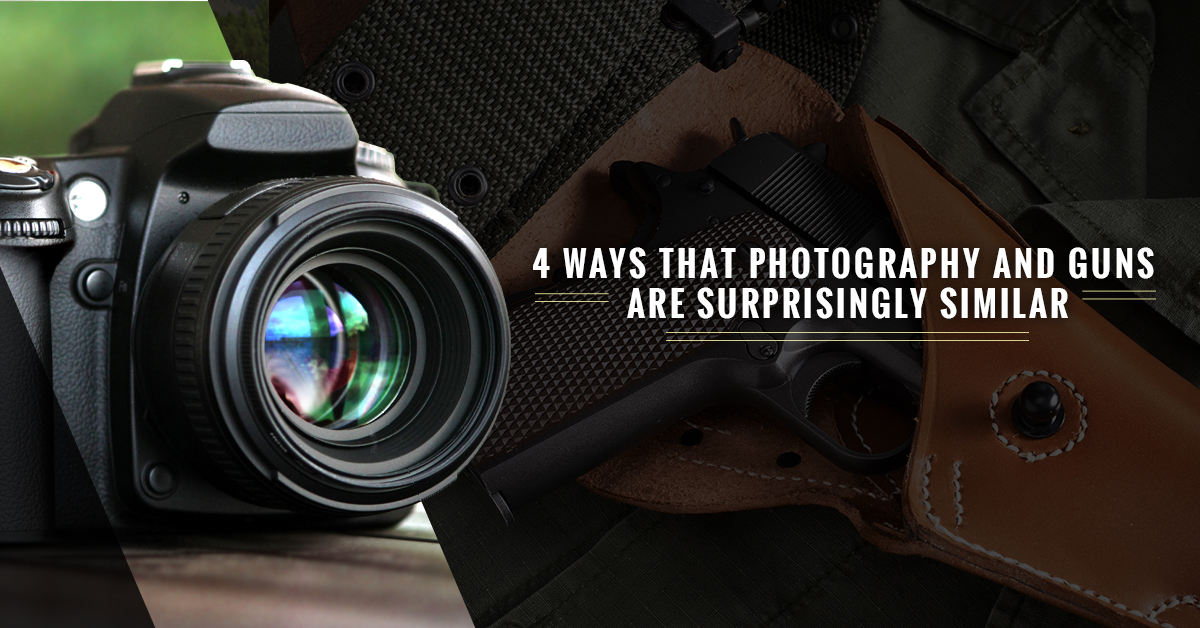In our last blog we were discussing the various aspects of hiking that will determine which revolver you take with you, as well as the specific revolvers that are right for those situations. And once you pick the right revolver, it’s not a bad idea to have a speedloader or a loaded moon clip at the ready for fast reloads. Of course, an easy draw from a revolver holster is also a must when you’re in a sticky situation.
Writing those articles got us thinking: when you’re on a hike, you really don’t want to have to draw your revolver. After all, if you do draw it, more often than not means that something is wrong. After all, you don’t want to be shooting at stuff when you’re out enjoying nature because it’s much more likely that you’d rather be taking pictures. Then we started thinking about cameras and how similar they are to guns. At first, the idea might seem ludicrous, but the fact is that there are many easy-to-see correlations between the two interests. Let’s get started with an obvious one.
You’re Shooting Something
Photography came along after firearms, so it’s pretty obvious that the idea of “shooting something” started with a gun. Or, since bows and arrows predate firearms, maybe that’s what started the idea of shooting.
Photography came along, and it seemed to mimic quite a few of the features of gun shooting. You “took aim” at something, you “sighted” it, and the idea of a trigger was the same between them — you touched a lever and something happened. At first, it occurred much slower with cameras, because the sensitivity of the film at the time might require five minutes just to take a portrait. But as film got better, Kodak encouraged people to take pictures of everyday life…thereby giving us the term “snapshot.” Heck, some rolls of film, such as the small 110 film that was popular in the early 1980s, are even known as cartridge film.
Interestingly enough, you end up shooting many of the same things with both guns and cameras. Both shoot animals and both shoot landscapes (that’s what plinking is all about!). And while they both shoot nature, cameras certainly have the advantage when it comes to shooting in the city.
They’ve Evolved So Much That It’s Hard To Recognize Them
If you’re familiar with the history of the gun, you know just how much they’ve evolved over the centuries. Gunpowder was discovered, but it took advanced metallurgy to allow someone to safely hold it in their hands. Flintlocks, rifling, black powder, cartridges, revolvers, semi-autos, machine guns, and laser sites — all of these have changed the gun over the last 700 years.
Photography hasn’t been around nearly as long as long as firearms, but it’s seen a similar amount of changes, so much so that the earliest cameras look nothing like those of today. People experimented with different metals and chemicals (including eggs, something called albumen photography) in order to create an image of collected light that would stay fixed in place, something that was finally accomplished in 1826. From there the process went through many iterations, including daguerreotypes and finally to light-sensitive film. Film got better (much as bullets have) and cameras got more reliable (just as revolvers have). There have been dozens of film formats over the years, including 35mm, 126, 110, 6X6, 120 (seems gun owners all like numbers too: do 9mm, .357, .38, and .44 sound familiar?). Cameras moved from single sheets to rolls of film, just as guns moved from musket ball to cartridge. Of course, cameras had that huge change in the last two decades when most everyone switched from film to digital. While firearms haven’t made the digital change yet, there’s no doubt that the military is investigating handheld lasers as weapons.
We Love the Numbers
We were just talking about numbers in that last paragraph, and it’s interesting that camera film, camera lenses, and cartridges almost all use millimeters as their measurements. Still, those aren’t the only numbers we deal with on a daily basis.
Both camera people and firearm people love to talk numbers and stats. What’s the rate of fire? (The Canon 7d Mark II shoots 10 frames a second, the M4 shoots 950 rounds per minute.) What’s the accuracy? (The 5d Mark IV has 61 autofocus points, the Thompson Contender is the most accurate hunting handgun out there). Muzzle velocity, low-light performance, trigger pull, buffer space…whether you’re arguing brands or models, someone always wants to point to a number to tell you which one is better.
We’re obsessed with numbers! And while there are masters out there who can take a wall-worthy picture with an old cell phone and someone out there who can use an ancient .22 with great accuracy at 200 yards, there’s always going to be that argument that “better numbers makes a better piece of equipment.”
There’s Always Something Else To Buy
If you’re like us, you’re not that interested in clothing and fashion. The fact is that most of our customers are men, and, sorry to devolve into stereotypes here, but it’s very likely that your wife spends more money and time on clothes and jewelry than you do. Still, that doesn’t mean that men don’t like to accessorize!
When it comes to both guns and photography, there’s always something more to buy. With revolvers, it starts with the gun itself: one is never enough! Then there’s the revolver holster, and you might have a few for each (one-speed holster for competitions, one for walking around, one for concealed carry). Then there are scopes, speedloaders, ammo boxes, moon clips, reloaders, hard cases, safes (never forget the safe), and, of course, multiple types of ammo depending on the situation at hand.
The same is true with cameras because camera people love to add stuff on. It starts with the camera body, but these days it needs to be replaced every few years when a significantly improved model comes out. Then there are the lenses, which often cost more than the camera itself. Instead of revolver holsters, there are custom shoulder straps; instead of cartridges, there are high-speed memory cards. Hard cases give way to padded bags, battery grips are like speedloaders, and safes are like, well, safes (camera people don’t need them as large, of course, because there aren’t many lenses as long as rifles).
Alright, that’s only four ways in which photographs and guns are similar, but we have so many more that you’d better stop by next time for another blog. Until then, accessorize your revolver with the best in revolver holsters, speedloaders, and moon clips from Speed Beez!


